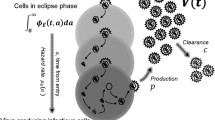Summary
Time intervalst between infection of HeLa, ERK and MK cells and attainment of 50 per cent cytopathic endpoint have been determined for virus inoculaV of different magnitudes. Data from numerous experiments carried out with polioviruses 1, 2 and 3, coxsackieviruses A 9 and A 21, echovirus 11 and vaccinia virus, with or without virus inhibitors, statistically satisfy the regression line log(t s −t)=n log logV+logB, wheret s is the value oft whenV=1 TCID50 unit andn andB are constants. Regression lines for an experiment with a single virus-cell system and different inhibitors pass through or near a common point. A measure of the cytopatho-genicity of the virus under the experimental conditions is given by n−1.
Ifn is the slope of the regression line in the presence of an inhibitor (of viral CPE)I, possessing concentration [I] (>0), and n0 is the slope in its absence, then then-n0 value is shown, in the case of the three polioviruses under certain conditions, to be related to [I] by the equationn−nin0 = Q[I]P, whereP andQ are constants. The cell protective activity (A) ofI is defined as Q1/P.
If formation in infected cultures of substances or conditions hostile to viral multiplication does not occur until the viral TCID50 approaches a specific high valueV H , then the increase in “infective virus” in a culture corresponds to travel along an appropriate regression line (α) towards the point of intersection.
Similar content being viewed by others
References
Dougherty, R. M.: Animal virus titration techniques. In: Techniques in Experimental Virology (R. J. C. Harris, ed.), pp. 169–223. London: Academic Press, 1964.
Fischinger, P. J., andT. E. O'Connor: Tissue culture assay of helper activity of murine leukemia virus for murine sarcoma virus. J. nat. Cancer Inst.43, 487–489 (1969).
Hahn, G. M., A. Declève, M. Leiberman, andH. S. Kaplan: Focus formation by a murine sarcoma-leukemia virus complex. 1. Theoretical analysis. J. Virol.5, 432–436 (1970).
Koch, A. L.: Encounter efficiency of coliphage-bacterium interactions. Biochim. biophys. Acta (Amst.)39, 311–318 (1960).
Ogston, A. G.: On uncertainties inherent in the determination of the efficiency of collision between virus particles and cells. Biochim. biophys. Acta (Amst.)66, 279–281 (1963).
O'Sullivan, D. G., C. Ludlow, D. Pantic, andA. K. Wallis: Antiviral activity and molecular features of benzimidazoles. In: Antimicrobial Agents and Chemotherapy — 1969 (Proceedings of the Ninth Interscience Conference on Antimicrobial Agents and Chemotherapy, Washington 1969), pp. 153–159. American Society for Microbiology. Bethesda, Maryland, 1970.
O'Sullivan, D. G., C. M. Ludlow, andA. K. Wallis: The high activity of fluorohydroxybenzylbenzimidazoles against some small RNA-viruses. Experientia (Basel)27, 1025–1027 (1971).
O'Sullivan, D. G., D. Pantic, andA. K. Wallis: D-5-ChIoro-2-(α-hydroxybenzyl) benzimidazole and 1-alkyl-5-chloro-2-(α-hydroxybenzyl)benzimidazoles as inhibitors of picornavirus multiplication. Experientia (Basel)24, 661–663 (1968).
O'Sullivan, D. G., andA.K. Wallis: New benzimidazole derivatives with powerful protective action on tissue-culture cells infected with types 1, 2 and 3 poliovirus, Nature (Lond.)198, 1270–1273 (1963).
O'Sullivan, D. G., andA. K. Wallis: Antiviral benzimidazoles. Direct 1-substitution of 2-(α-hydroxybenzyl)benzimidazole and related compounds. J. med. Chem.15, 103–104 (1972).
Valentine, R. C., andA. C. Allison: Virus particle adsorption. 1. Theory of adsorption and experiments on the attachment of particles to non-biological surfaces. Biochim. biophys. Acta (Amst.)34, 10–23 (1959).
Author information
Authors and Affiliations
Rights and permissions
About this article
Cite this article
O'Sullivan, D.G., Ludlow, C.M. Relation between the time at which cytopathic endpoint occurs in infected cultures and the initial infective virus dose, with application to the study of inhibitors of cytopathic effect. Archiv f Virusforschung 41, 295–309 (1973). https://doi.org/10.1007/BF01250202
Received:
Issue Date:
DOI: https://doi.org/10.1007/BF01250202




